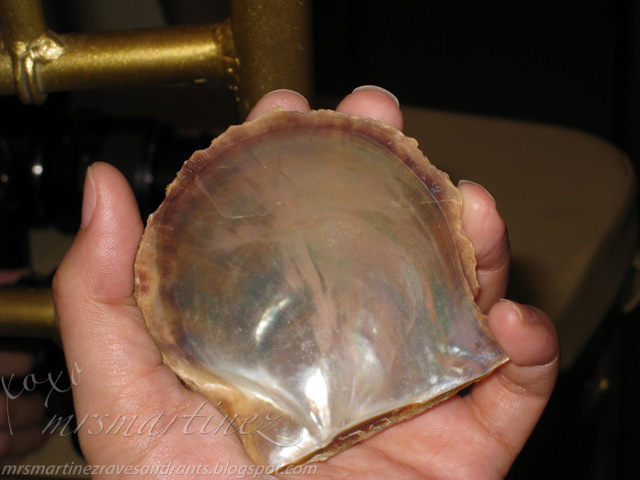My event: June 25, 2010
Pearl Talk 101
Jewelmer
Eastwood Mall
This post is meant as a guide in buying a pearl. The following are discussed- qualities of a pearl, kinds of pearl, how to spot a real pearl from a fake, and lastly, how to take care of your pearl.
Shape, Skin Purity, Color, Size and Orient- These are the five qualities you should consider before buying a pearl. The primary factors should be skin purity and orient/luster.
Color
Gold, light champagne, champagne, white, pinkish white, rose, silver and blue are the various shades of pearls. The pearl gets its color from the lip of the mother of pearl. Choosing a color is a matter of preference but always put into consideration the richness and the even distribution of color in pearls.
Size
Pearls are measure in millimeter. Average size is from 11 to 13mm. Although some are measured as small as 8mm to as big as 18mm.
Orient/ Luster
The orient/ luster is the amount of light reflected from the pearl's surface. The luster/glow, mirror light reflection, in each pearl is very important because it means that the nacre quality is good.
Skin Purity/ Surface Perfection
Consider pearls with tiny or minimal imperfection on the surface as more valuable than those with blemishes. Although these blemishes are part of the pearls natural texture and as such proof of the genuineness of the cultured pearl.
Shape
You should opt for the perfectly round shape but it will surely cost you a lot of money because it is the rarest and most valuable lol Now, other shapes are available like button pearls which are round on one end and flat on the other. Baroque are more often than not favored because of its unique shape.
Pearls are organic gems meaning they came from living organism.
Pearls are composed of nacre- a natural substance produced by mollusks that also covered the inside of the animal's shell.
You wouldn't believe that pearls are formed as a defense against intrusion but that's the truth! Cultured pearl is the result of induced intrusion. When you say cultured pearl, it means the result of human assistance in an otherwise natural process.
There are two types of pearls- freshwater pearls and salt water pearls.
Freshwater pearls are produced by mussels that live in freshwater while salt water pearls are produced by oysters that live in salt water. Generally speaking, fresh water pearls are a lot cheaper than salt water pearls. The reason is that the gestational period for fresh water pearl is only 6 months while salt water pearls can take up to 36 months. Fresh water pearls can grow in not even the cleanest water you can find mostly in lakes, ponds and rivers found in Japan, China and the USA. It can nucleate and produce up to 50 pearls. Most shapes are imperfect and round ones are very rare. Size ranges from 2mm to 13mm.
There are three kinds of salt water pearls- Akoya pearls, Black south sea pearls and the south sea pearls.
Akoya Pearls (Pinctada Fucata Oyster)
Grows within 8- 24 month period with sizes ranging from 2mm-10mm. Brown, copper and yellow green are the natural colors but most often than not Akoyas are bleached with hydrogen peroxide. They are found in Japan, China, Korea and some parts of South East Asia.
Black South Sea Pearls (Pinctada Margaritifera/black-lipped oyster)
Grows within 12 to 26 months with sizes ranging from 8mm to 20mm. Colors are gray, greenish, dark green, pistachio, peacock green and black. Black South Sea pearls are produced in French Polynesia (Tahiti and South Pacific).
Grows within 20 to 36 months with sizes ranging from 9mm to 24mm. South sea pearls are the biggest pearl-producing oysters. Silver- lipped colored pearls are silvery, bluish, white and pinkish white while gold- lipped oysters are cream, champagne, creme rose and golden colors. Producers of silver- lipped pearls are Australia and the Philippines while gold- lipped oysters are produces by Indonesia and the Philippines.
There are quite a number of factors like x- ray machines, gemological equipment and laboratory. What I did? I rub both pearls against each other. If there is a gritty powdery feel to it then its real ; ) And I bought from a reputable jeweler.
How to Take Care of Pearls
Pearls should be the last piece that you have to wear in the morning and the first thing you take off at night.
Clean using a soft damp cloth
Store separately from your other jewelry
Strands should be restrung at least once a year. I had mine restrung in Greenhills for only PhP400 with knots in between.
Store your pearls in an atmosphere with some moisture
Don't wear pearls when swimming, showering or doing some cleaning.
Never steam clean pearls or placed in an ultrasonic cleaner
Thanks Jewelmer for an enlightening afternoon!
Help Save Palawan Seas Foundation by wearing a pearl.
To vieew my Jewelmer pearl earrings, click here.

Related Site
-Free Food Recipes Online
-Food and Drink Magazine
Related Videos :below I show related videos and not so related to this article.
Nicolas Reveles describes the beauty and enchantment of "The Pearl Fishers," a new production of the San Diego Opera. The story, placed in a tropical paradise, tells of a tribal chief and a daring pearl fisher whose friendship is challenged when they both fall in love with a forbidden priestess. Series: "San Diego OperaTalk! with Nick Reveles" [9/2003] [Humanities] [Arts and Music] [Show ID: 7480]
Anthrax's Scott Ian & Pearl talk to Eric Blair @ The Golden God Awards















.jpg)




0 comments:
Post a Comment